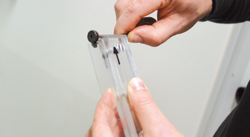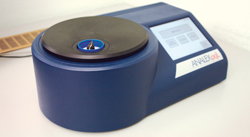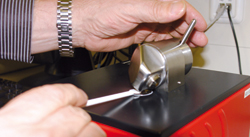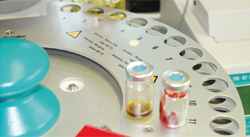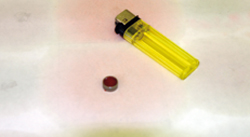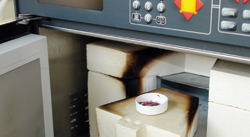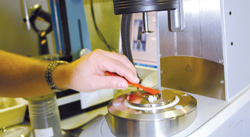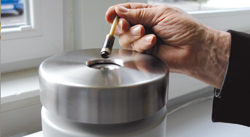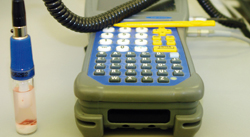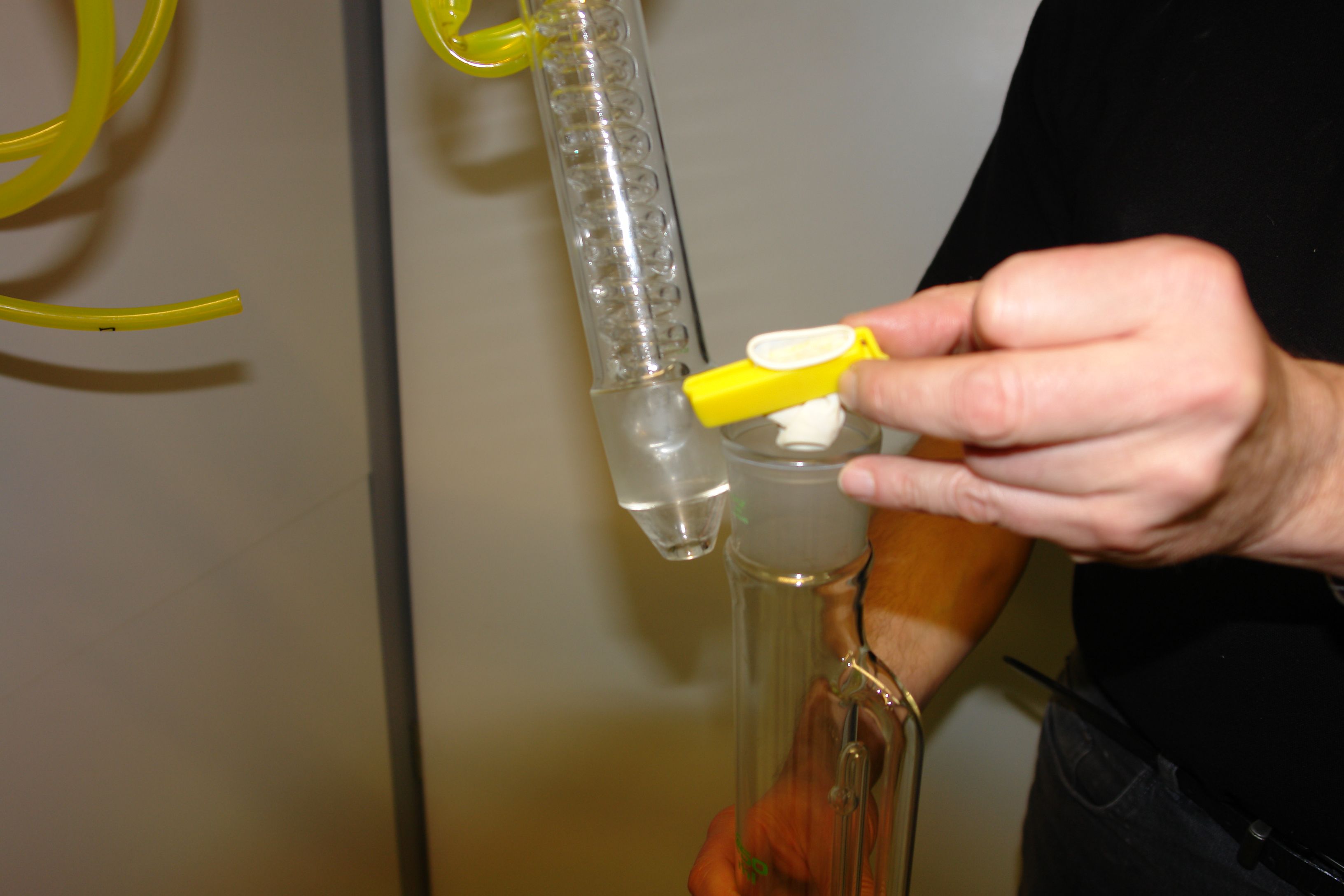Analysis methods for greases
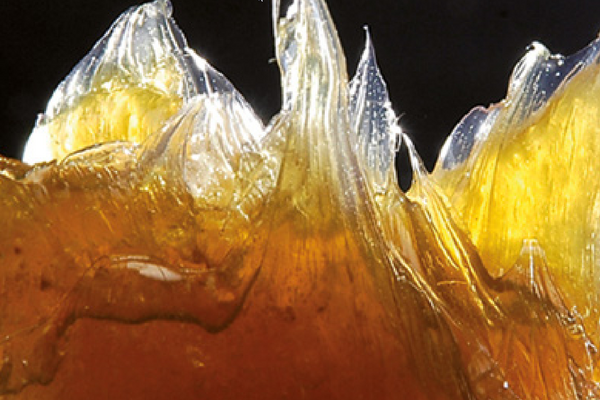
Table of contents
- AES – the base analysis for all
- PQ Index – searching for iron
- FT-IR – basic oil type and state
- Water analysis, Karl-Fischer titration
- Bleeding test - lubricating effectiveness of residual oil content
- Penetration – consistency
- Sulfatasche – Verschleiß und Verunreinigungen
- Shear stress, visible viscosity – rotation speed suitability
- Dropping point – temperature resistance
- Re-lubrication intervals with the RULER
- Base oil viscosity using Soxhlet extraction
- Neutralisation number
- Copper corrosion
- Recommended activity
AES – the base analysis for all
After homogenisation, OELCHECK looks at 27 elements. These provide information in mg/kg about wear, impurities, thickeners and additive levels in the sample.
Wear metals: Iron, chromium, tin, copper, lead, nickel, aluminium, molybdenum and zinc as well as possible levels of vanadium, titanium, silver, antimony, manganese and tungsten.
Impurities: Silicon, calcium, sodium, potassium, aluminium, cadmium, bismuth.
Additives, thickener or soap levels: Lithium, magnesium, calcium, phosphorus, zinc, barium, silicon, aluminium, molybdenum and boron.
AES information:
- Increased iron and chromium values indicate that a rolling bearing has been subject to wear; copper, lead and tin show corrosion or abrasive wear from bearing cages.
- Possible impurities, such as silicon (dust), calcium (lime) or hard water deposits help to identify the causes of wear.
- Deviations between fresh and used grease in terms of the content and composition of the additive package or the thickener show that another grease is being used.
PQ Index – searching for iron
The PQ Index (Particle Quantifier Index) is specialised in determining magnetisable iron particles. Unlike AES, which cannot easily detect iron particles >5 µm, it records all the wear particles which are magnetisable, regardless of their size. The height of the PQ Index is then measured in conjunction with the AES iron content. As an index the PQ value is dimensionless.
PQ Index information
- An extreme PQ index (e.g. over 500) indicates, regardless of the AES iron values, that acute wear has taken place. Often there has been pitting or material fatigue.
- If there is a high PQ level (e.g. over 200) and at the same time the AES indicates a low iron value (e.g. under 100), acute wear is occurring and causing relatively big wear particles.
- An increased PQ index (e.g. over 100) in combination with a correspondingly high AES iron value is a sign of typical material fatigue, during which „normal“ wear occurs.
- A low PQ index (under 50 or O.K.) accompanied by a high AES iron value (e.g. over 100 mg/kg) is always a sign of corrosion and rust formation. Rust is barely magnetisable so produces a low PQ index.
FT-IR – basic oil type and state
The principle of FT-IR (Fourier Transform Infrared) spectroscopy is based on there being different molecules present in a lubricant which, because of their typical chemical structures, absorb infrared light to different degrees with certain wavelengths. Changes to the used lubricant can be compared to the fresh grease reference spectrum and depicted, calculated and interpreted as typical „peaks“ for certain „wave numbers“. In addition to identity controls, oxidation can also be proven with FR-IT spectroscopy, for instance. As they age, molecular compounds alter and absorb more infrared light than fresh grease. Through the process of Fourier transformation, these values can be read and the molecular vibrations represented in an FT-IR diagram. Depending on the molecular compounds, the peaks develop as corresponding wave numbers. Synthetic lubricants frequently contain ester-based components. Because of the oxygen molecules contained within them, they absorb infrared light in almost the same wavelength range as the double oxygen bonds which arise through oxidation. That is why oxidative changes to a synthetic oil cannot be calculated accurately using IR alone. The RULER test is needed to do this.
FT-IR spectrum information
- Through comparison with the deposited fresh grease spectra, the process provides quick and reliable information on whether greases have been mixed together or whether a completely different type of grease has been used.
- The process can also determine whether the grease that has been examined contains mineral-oil-based base oil or synthetic base oil.
- For mineral-oil-based base oil, the FT-IR determines whether oxidation has taken place because of a lack of re-lubrication or because of damage caused by high temperatures.
- If a grease contains high-pressure additives, e.g. zinc phosphorus base, additive deterioration may be detected.
- A fresh grease comparison can also prove whether there is too much water.
Water analysis, Karl-Fischer titration
Too much water in grease may cause corrosion and bearing damage. In places with high relative movement, cavitation can occur. If too much water is present or water penetrates continuously, re-lubrication must be done more frequently. If the grease cannot withstand the water it may become soft or watery and the quality will drop.
The amount of water in a grease sample is calculated exactly using the Karl-Fischer method in ppm (mg/kg), the same method as for oil. To do this, water must be „driven out“ of the sample. With oil, the water from the sealed sample is steamed away by heating it to temperatures of up to 140 °C, but it is much harder to boil the water out of grease. In this case, the water must be extracted slowly at a temperature of 120 °C. The water is channelled into a titration vessel using a hollow needle and nitrogen. Here, an electrochemical reaction takes place with a special KF solution. Once the transition point of the titration curve has been reached, the exact water content can be stated.
K.F. information Water analysis
- If a grease contains too much water, it is important to track down the origin and to eliminate it. The Karl Fischer method provides quantitative information about water content. The elements investigated by the Atom Emissions Spectroscopy process help to distinguish between condensate and tap water.
- If unlike the fresh grease sample the used grease sample is polluted with sodium, calcium, potassium or magnesium this points to „hard“ water. It may have penetrated the grease during high-pressure cleaning. If these minerals are not present it may be „soft“ rain or condensed water.
- If water has not been satisfactorily removed during the production of the grease, it may be found in fresh grease. An analysis of fresh and used grease clarifies this matter.
Bleeding test - lubricating effectiveness of residual oil content
The sponge-like structure of the thickener or soap used in grease holds the base oil firm and allows it to transfer slowly to the lubrication point. But if the oil flows too quickly and uncontrollably from the thickener structure, the grease „bleeds“ away. If the remaining thickener contains too little oil for the lubrication tasks, the remaining grease dries out. If the residual oil content of a grease falls too quickly, either the grease at hand is unsuitable or it must be reapplied more frequently or in larger quantities. Determining the residual oil content provides the necessary information to decide which. The test shows the percentage of base oil that the soap structure has lost over the course of six hours, at a temperature of 80 °C. The residual oil content of used grease should then be compared with the fresh grease sample.
Bleeding test information
- If the values are between 5 and 25% and the difference between the used and fresh grease is +/- 15% or less, the grease can still be used without changing the re-lubrication intervals.
- If the used grease loses considerably more oil than the fresh oil, the thickener is no longer able to maintain the base oil in its sponge-like structure.
- If considerably less oil is released from the used grease, it has already begun to dry out. The bearing surface is „hungry“ for lubrication. It must be lubricated again.
- Residual oil content levels which are too low may be caused by the following:
- too much usage time and lack of or insufficient re-lubrication
- strong vibrations, load or rotation speeds
- mixing of greases which have been saponified differently
- impurities caused by water, acids or lyes
- insufficient temperature resistance
- oxidation and ageing (acetifying) of the base oil
Penetration – consistency
While viscosity describes the ability of a lubricating oil or a hydraulic fluid to flow, consistency refers to the extent to which a lubricating oil is stiff. However, the consistency of a grease is not directly linked to the viscosity of its base oil or the kind of thickener used. The National Lubricating Grease Institute (NLGI) in the USA divides lubricating greases into classification groups based on their consistency.
| NLGI classes | Penetration number | Consistency at room temperature |
000 | 445 - 475 | Very liquid |
00 | 400 - 430 | Liquid |
0 | 355 - 385 | Semi-liquid |
1 | 310 - 340 | Very soft |
2 | 265 - 295 | Soft |
3 | 220 - 250 | Semi-solid |
4 | 175 - 205 | Solid |
5 | 130 - 160 | Very solid |
6 | 85 - 115 | Extremely solid |
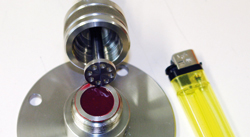
Sulfatasche – Verschleiß und Verunreinigungen
Investigating sulphate ash is a process used to determine inorganic (firm) levels in organic samples. This is determined by heating the sample to temperatures of 775 °C. At this temperature the organic elements in the samples „combust“ (e.g. the oil). All that remains are ashes, which consist of metallic oxides (soap, additives) and impurities. By smoking this with concentrated sulphuric acid, the oxides in the ashes are transformed into sulphates. The weight of the remains is then recorded.
Information about sulphate ash
- If the proportion of sulphate ashes in the used grease has increased compared to the fresh grease, this is a clear indication of impurities and/or wear.
- If the metal values determined by the AES process are also consulted at this stage, the cause of the weight increase can be clarified. High levels of iron and chromium point to wear, while increased proportions of silicon and calcium hint at impurities.
- The weight of the sulphate ash is affected by:
- metallic abrasion from bearing wear
- hard impurities such as silicon (dust), which often indicates that too much time has passed between re-lubrication intervals
- levels of solid lubricants such as MoS2
- metal organic EP additives
- other metal soaps and inorganic thickeners, recorded with another grease they have been mixed with
Shear stress, visible viscosity – rotation speed suitability
A rheometer is used to measure the visible viscosity of a grease at different temperatures. For this purpose a small amount of grease is placed on a temperature-controlled plate. The plate-based testing cone, which develops a gap between the upper and the lower plates, moves on to the film of grease. The force between the plates and the cone is measured as dynamic viscosity, which for grease is also called „shear viscosity“. The stability after the shearing, which, for instance, assesses characteristics such as deformability of a lubricating grease, can be described in apparent viscosity terms. The rheometer gives the shear viscosity at the beginning and the end of the testing procedure and displays the shear viscosity decrease in percentage terms.
Information about apparent viscosity
Using the index, particularly when compared with different fresh greases or through trend analyses, the following can be determined:
- whether the grease is suitable for high rotation speeds.
- the lower temperature limit at which the grease can be used.
- whether the grease is suitable for specific types of bearing (spherical roller bearings).
Dropping point – temperature resistance
As temperatures rise, lubricating greases behave differently to edible fats. They do not melt like butter or coconut oil when warmed. Lubricating greases hardly change at all as the temperature rises because the thickener holds the base oil firm. Only when the thickener‘s critical temperature has been reached does the soap structure dissolve.
To determine the dropping point, a grease sample is warmed in the testing device until liquid drops fall through the opening of a nipple to the bottom of the test tube. Gel or powder-based lubricant greases which are measured at temperatures of over 300 °C are considered as not having a dropping point.
Information about dropping points
There is not always a correlation between a grease‘s dropping point and its maximum operating temperature. Of course, the permissible temperature is always less than the dropping point value. Not just the thickener, but most of all the type of oil are what determine a grease‘s maximum operating temperature.
A lower dropping point of a used grease in comparison to a fresh grease may be caused by the following:
- Greases with different thickeners which have been mixed together. In general this reduces the dropping point. The used grease does not just become softer. It often reacts like a semi-fluid product when the temperature rises.
- The grease contains water or other foreign fluids.
- Under extreme load the grease shears into extremely small particles. The soap structure has collapsed and can no longer bind the base oil.
Re-lubrication intervals with the RULER
The RULER test, a process based on cyclical voltametry, establishes the amount of amino and phenol oxidation inhibitors in a grease sample.
Like all oil, even lubricating greases are altered by factors such as time and temperature. That is why, in addition to EP and AW additives, they also contain antioxidants. These can break down. The re-lubrication intervals and amounts must be adapted to decreasing additive levels.
IR spectroscopy can be used to accurately determine the development of oxidation in mineral-oil-based greases. No IR oxidation figures can be calculated for synthetic base oils. That is why oxidation cannot be determined for high temperatures grease using the FR-IT spectroscopy. The RULER test is used for such greases in particular.
Information about RULER tests
By comparing the curves of fresh and used greases:
- the remaining lifespan of a grease can be determined.
- the best time for the next re-lubrication due to oil ageing can be calculated.
Base oil viscosity using Soxhlet extraction
As base oil viscosity is one of the decisive factors when trying to calculate bearing life spans, most lubricant grease manufacturers provide information on the viscosity of the base oil that is being used. However, there are no clear regulations regarding this matter. In general, high viscosity is considered better. To be able to indicate high viscosity, all fluid components such as oil, additives, adhesive additives, VI improvers are mixed. The viscosity is stated based on this mixture. However, this viscosity has very little in common with the way that viscosity is calculated for oil used in roller bearings because the grease no longer releases some parts of the thickener on to the bearing track.
The Soxhlet apparatus can separate the liquid grease component from the thickener. The oil which is extracted in this process only contains liquid components. Polymer or adhesive supplements, VI improvers and even solid lubricants remain in the thickener.
Information about base oil viscosity
After the oil-based components have been divided from the soap, information can be provided about the oil and thickener levels in a grease. Separating them into solids and oil makes it possible to carry out a detailed analysis of the base oil that has been used, with respect to:
- its viscosity – whether it is highly viscous or not and what viscosity level is actually available to the bearing surface.
- its base oil composition – mineral or synthetic.
- its proportion of additives, such as EP additives, antioxidants and corrosion inhibitors.
Neutralisation number
Even greases can turn „sour“. Oxidation of base oil, the breakdown of wear protection additives or the entry of salted fluids result in the development of acids in the lubricant grease. These can destroy alkaline thickeners so that the grease takes on a soup-like consistency and the base oil and soap residue separate. The grease runs off the bearing surface. Unless it is re-lubricated at regular intervals, bearing failure may occur.
Information about neutralisation numbers
- The fat has become acidic because of various reactions. Re-lubrication should take place at more regular intervals.
- The grease is not suitable for use. Either the base oil or the thickener should be improved.
Copper corrosion
A copper strip is covered with grease on all sides and placed in a specimen container with the same grease. The sealed sample container is stored for a certain amount of time in a warming bath. Once the test period has finished, the copper strip is removed, cleaned with solvent and dried carefully.
The level of corrosion at the end of the experiment is ascertained by comparing the discolouration of the copper strip on a colour scale.
The technique is used to investigate the corrosive characteristics of greases in the presence of copper. This is because the sulphur level alone does not provide enough information on the corrosion of metallic machine parts that can be expected.
Information about copper corrosion
- How does the grease behave in terms of non-forous metal corrosion when used in bearing cages?
- Do the additives, coloured metal deactivating agents that are supposed to reduce the effect of sulphur compounds, still work?
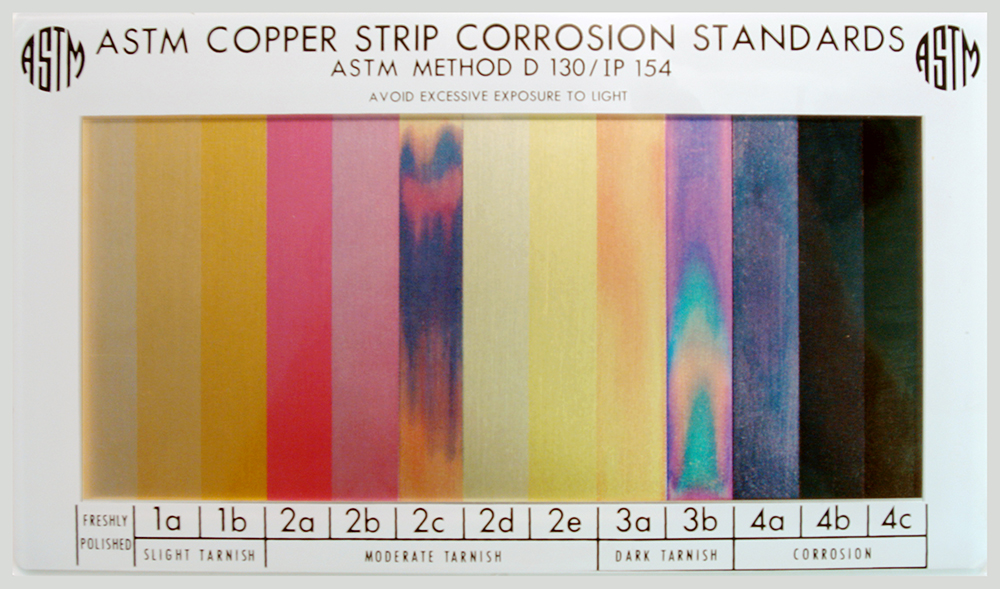
Recommended activity
If you plan to switch to another variety of grease, or if the individual values have changed so considerably that the laboratory report is labelled with a „?“ or „i“ symbol, the used grease still present should be removed from the lubrication point. Where possible, this should also be cleaned. If this is not possible, then larger amounts of grease must be used to re-lubricate more frequently.
Related information
ÖlChecker Winter 2012, Seite 4 - 8

